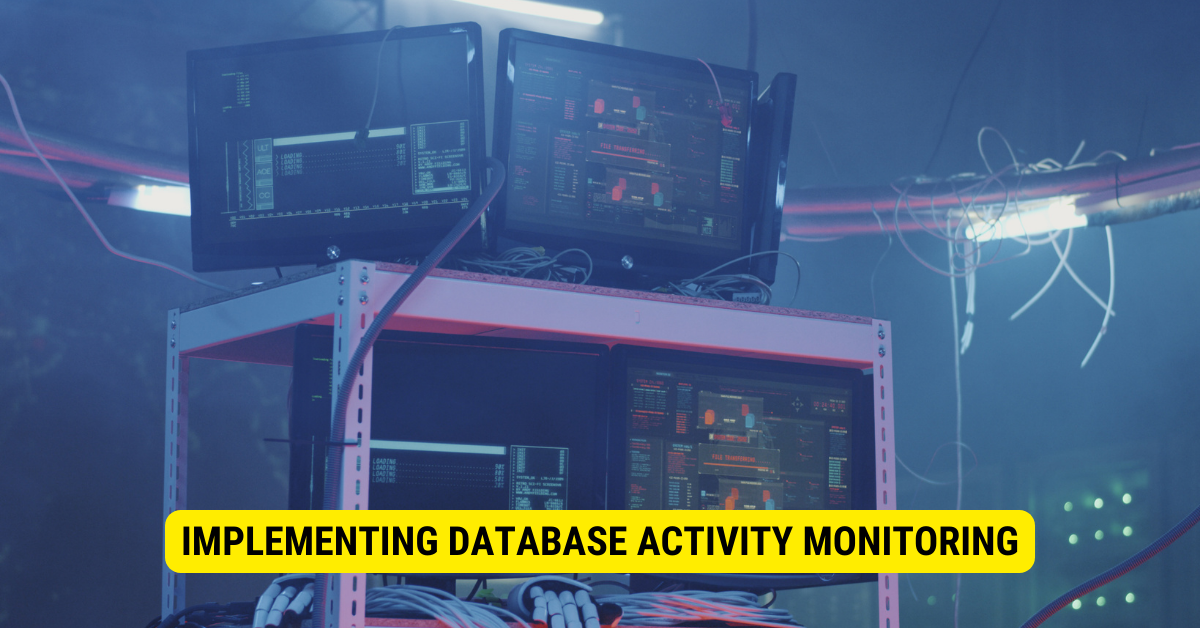A Database Activity Monitor increases security by continuously monitoring and auditing database activities, detecting suspicious or unauthorized access, and providing real-time alerts. This helps prevent data breaches, unauthorized data access, and ensures compliance with security policies.
Data security is a serious anxiety for businesses and organizations in today’s digital landscape. With growing cyber threats and data breaches, safeguarding sensitive database information has become paramount. One effective tool that helps in enhancing data security is the Database Activity Monitor (DAM). I will explore how DAM works, its benefits, and why it is essential to any organization’s security arsenal.
Understanding Database Activity Monitor (DAM)

Database Activity Monitor (DAM) is a sophisticated software solution designed to monitor and analyze real-time database activity. It tracks all interactions with the database, including queries, logins, modifications, and access attempts. DAM operates by capturing and recording these activities and providing administrators with detailed reports and alerts, enabling them to identify potential security threats proactively.
DAM is typically installed on a database server or within a network where it can have visibility into all database-related activities. It functions as a non-intrusive layer, analyzing database traffic without affecting normal operations. The collected data is then handled and analyzed using various algorithms and machine-learning techniques to detect anomalies and suspicious patterns.
How Data Base Activity Monitor Increases Security?
A Database Activity Monitor (DAM) increases security in several ways:
- Continuous Monitoring: DAM constantly monitors all activities within the database environment in real time. It tracks interactions such as queries, logins, modifications, and access attempts, ensuring that every action is scrutinized for potential security risks.
- Early Threat Detection: By actively monitoring database activities, DAM can promptly detect suspicious or unauthorized access attempts and abnormal behavior by legitimate users. It raises real-time alerts whenever it identifies potential security threats, allowing administrators to take immediate action to mitigate risks.
- Insider Threat Identification: DAM can also detect insider threats involving employees or authorized users exploiting their access to compromised data. It recognizes unusual behavior patterns, helping to identify unauthorized access or data misuse from within the organization.
- Protection against SQL Injection Attacks: SQL injection attacks are a common method hackers use to manipulate databases and extract sensitive information. DAM can detect and prevent such attacks by identifying unusual query patterns and blocking malicious queries before they cause harm.
- Compliance Assurance: Compliance with industry regulations and data protection laws is crucial for organizations. DAM helps ensure compliance by providing detailed audit logs and reports demonstrating that the organization is taking necessary measures to protect sensitive data.
- Behavioral Analysis: DAM often incorporates behavioral analysis capabilities, establishing a baseline of normal behavior within the database. DAM raises alerts to indicate potential security issues when deviations from this baseline occur, such as unexpected access or large data queries.
- Non-intrusive Operation: DAM operates as a non-intrusive layer in the database environment, analyzing traffic without affecting regular operations. This ensures the monitoring process does not introduce vulnerabilities or disrupt system performance.
- Visibility into Database Activities: DAM offers administrators a comprehensive view of potential security risks by providing detailed insights into all database-related activities. This prominence allows them to make informed decisions and implement appropriate security measures.
A Database Activity Monitor is vital in enhancing data security by actively monitoring database activities, detecting real-time threats, preventing attacks, and ensuring compliance with security policies and regulations. It is essential in protecting sensitive data and maintaining a robust security posture for businesses and organizations in today’s digital landscape.
The Benefits of Database Activity Monitor
Enhanced Threat Detection
One of the primary benefits of a Database Activity Monitor is its ability to detect potential threats in real time. It can identify unauthorized access attempts, abnormal behavior by legitimate users, and even insider threats. By continuously monitoring the database, DAM can raise alerts whenever suspicious activities are detected, allowing administrators to take immediate action.
Protection against SQL Injection
SQL injection attacks are a common technique hackers use to gain unauthorized access to databases. By injecting malicious SQL code, attackers can manipulate the database and extract sensitive information. Database Activity Monitors can detect and prevent such attacks by identifying unusual query patterns and blocking malicious queries before they cause harm.
Compliance and Auditing
Obedience with industry regulations and data protection laws is essential for many organizations. Database Activity Monitors ensure compliance by providing detailed audit logs and reports. These logs can demonstrate that the organization is taking proper measures to protect sensitive data and meet regulatory requirements.
Behavioral Analysis
DAM solutions often come equipped with behavioral analysis capabilities. By establishing a baseline of normal behavior, the system can detect deviations from this baseline. For instance, if a user suddenly attempts to access data they have never accessed before or queries an unusually large amount of data, the system will flag it as suspicious behavior.
Implementing Database Activity Monitoring

Selecting the Right DAM Solution
Before implementing a Database Activity Monitor, choosing the right solution that aligns with the organization’s needs is crucial. Factors to consider are; the type of databases used, the volume of data, scalability, and integration with existing security infrastructure.
Deployment and Configuration
Once the appropriate DAM solution is selected, it must be deployed and configured correctly. This involves installing the software on the designated database server or network, defining monitoring policies, and setting up alert mechanisms. DAM should be integrated with existing security tools to provide a comprehensive security framework.
User Training and Awareness
Proper user training and awareness are essential for successfully implementing a Database Activity Monitor. All relevant stakeholders, including database administrators, IT personnel, and other users, should be educated on the importance of DAM and how to respond to security alerts effectively.
Regular Updates and Maintenance

Consistent updates and maintenance are necessary to ensure DAM’s continued effectiveness. Database environments are dynamic, and new threats emerge constantly. Keeping the DAM solution up-to-date with the latest security patches and threat intelligence is crucial in avoiding potential risks.
The Future of Database Activity Monitoring
Database Activity Monitoring continually evolves to keep up with the ever-changing threat landscape. As cyber attackers develop more sophisticated methods, DAM solutions are becoming more advanced. Forthcoming developments may include the integration of artificial intelligence and machine learning to improve risk detection accuracy and reduce false positives.
Key Takeaways
- Database Activity Monitor (DAM) is a sophisticated software solution that offers real-time monitoring and examination of database activity.
- DAM enhances data security by detecting potential threats, protecting against SQL injection attacks, and ensuring compliance with regulations.
- Selecting the right DAM solution, proper deployment, user training, and regular maintenance are essential for successful implementation.
- The future of DAM involves the integration of unconventional technologies like artificial intelligence and machine learning for improved threat detection.
Frequently Asked Questions (FAQs)
Q1: How does Database Activity Monitoring differ from traditional database security measures?
A1: Unlike traditional security measures that focus on protecting the perimeter, DAM operates within the database environment, monitoring activities in real time. It provides insights into internal threats and can detect unauthorized access attempts and abnormal behavior by legitimate users.
Q2: Can Database Activity Monitoring prevent all types of data breaches?
A2: While DAM is a powerful tool for enhancing data security, it cannot guarantee absolute protection against all data breaches. It significantly reduces the risk of breaches but should complement other security measures, such as encryption and access controls.
Q3: Is DAM suitable for all types of databases and organizations?
A3: DAM solutions can be tailored to suit various databases, including relational, NoSQL, and cloud-based. It benefits organizations of all sizes that handle sensitive data and seeks to strengthen their security posture.
Q4: How often should Database Activity Monitoring be updated?
A4: Regular updates are crucial for DAM to stay effective against emerging threats. Ideally, updates should be applied when new patches and threat intelligence become available.
Q5: Can DAM help with compliance requirements?
A5: DAM plays a vital role in meeting compliance requirements by providing detailed audit logs and reports demonstrating the organization’s commitment to data security and privacy.
Conclusion
In conclusion, Database Activity Monitoring (DAM) is a crucial tool that significantly enhances data security for businesses and organizations in the face of increasing cyber threats and data breaches. By continuously monitoring and auditing database activities, DAM can promptly detect suspicious or unauthorized access and provide real-time alerts, helping to prevent data breaches and unauthorized data access. Additionally, DAM ensures compliance with security policies and regulatory requirements by generating detailed audit logs and reports.
